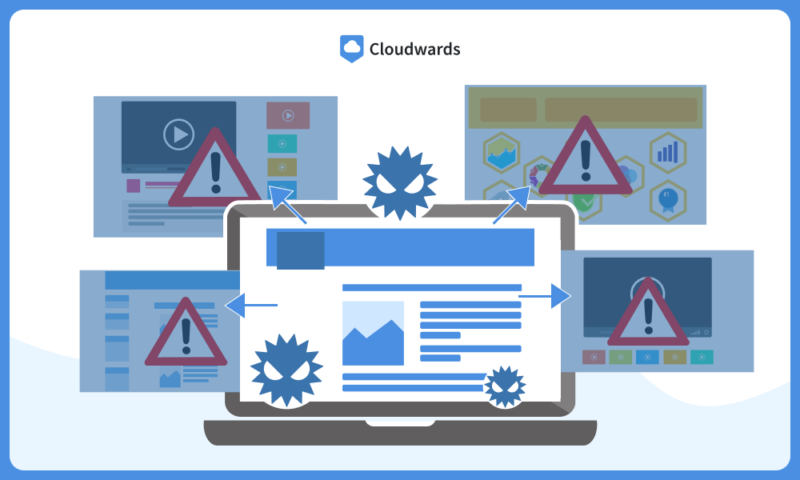What Is Browser Hijacking? How to Remove It in 2025
If you ever accidentally installed a weird browser toolbar, you’ve likely been the victim of browser hijacking. Though not as common as it once was, you can still run into hijackers, especially when downloading older software. In this guide, we answer the question "what is browser hijacking? and explain how to protect yourself.
A browser hijacker, also known as a browser redirect virus, is malicious software that manipulates a user’s web browser settings without their consent. Browser hijacking forces the browser to redirect to unwanted (and potentially dangerous) websites, impacting the victim’s online safety and privacy. Most browser hijackers come in the familiar form of suspicious toolbars, bundled with another piece of legitimate software.
Browser hijackers can be inconvenient, and they can also pose a threat. They generate advertising revenue for themselves by getting the victim to click on sponsored links, which can also lead the victim to dangerous websites. This is why it’s important to treat a hijacker just like any other virus and remove it as soon as you detect it.
-
03/28/2024 Facts checked
We rewrote the article to better reflect the current browser hijacking landscape. We also reorganized the article to present the most pertinent information to our readers.
-
05/29/2024
Updated the article to add custom graphics.
What Is Browser Hijacking Software?

Browser hijacking software is a type of computer virus that infects your browser and redirects you to websites you didn’t intend to visit. Such malware can change a user’s browser homepage, default search engine and other web browser settings. Browser hijacker software can often lead to clicking on malicious websites and infecting your device with other malware.
Because a browser hijacker modifies web browser settings, it can redirect users to a different search engine, which might lead them to click on suspicious links from the corrupted search results. In turn, this can lead to downloading unwanted software, including more malware. This is why you’ll sometimes see a browser hijacker referred to as a browser redirect virus.
Are Browser Hijackers Dangerous? The Impact of Browser Hijacking
Browser hijackers are rarely dangerous; mostly they’re just annoying to deal with. However, they are the perfect vessels for spyware and other dangerous practices. Here are some potential consequences of having your browser hijacked:
- Minor annoyances: The most common effects of browser hijacking include seeing an increased number of pop-up ads, having to manually change search engines or having to uninstall an unwanted toolbar.
- Identity theft: Your browser is a conduit for a lot of sensitive data, especially personal information. A hijacker can steal that information to impersonate you online.
- Password leaks: Similarly, someone with access to your browser can easily access passwords stored in it or ones you enter while being monitored.
- Browsing data leaks: Your browsing habits reveal a lot about who you are, and this info is priceless to marketing companies. A hijacker can harvest your browsing data and sell it to marketers.
- Malware infections: A hijacker can redirect you to malicious websites — even copycat websites made to look like legitimate sites. You can accidentally download a file from one of these sites and infect your device with a virus.
- Reduced computer performance: All computer programs have a negative impact on performance, and a hijacker is no exception, especially because its makers have no incentive to optimize its performance.
- Ripple effects: Though browser hijackers themselves are generally minor annoyances, they can drastically reduce your data security by redirecting your internet traffic or leading you to dangerous parts of the internet.
- Operating system modifications: Some viruses will make changes to your system registry in order to stay hidden from the user and become undeletable.
Examples of Browser Hijacking
Browser hijacker infections most often occur when a user downloads software that is packaged with an annoying toolbar. Here are the most prominent examples of browser hijackers:
- Babylon Toolbar: Part of the Babylon translation suite, Babylon Toolbar is meant to help with in-browser translations, but it deceptively changes users’ homepages and search engine settings.
- Conduit Search: One of the more annoying hijackers, this notorious adware is among the most dangerous spyware infections. It changes your default search engine to a Conduit site that it uses to collect data, but if you try to remove it, it can take your entire OS down with it.
- CoolWebSearch: Though originally a strictly Internet Explorer virus, it can now infect other browsers. Similar to Conduit Search, it can be very difficult to remove and can even spawn a dedicated browser hijacker removal tool called CWShredder.
Browser Hijacker Symptoms
Browser hijackers are some of the easiest malware to detect. Merely opening your internet browser will instantly reveal any changes made to it. Here are some common symptoms of browser hijacking:
- Your default homepage has been changed.
- Your browser’s toolbar looks different.
- The browser runs your search queries using a different search engine.
- You are redirected to copycat web pages or different ones than what you want to access.
- You get pop-up ads while browsing.
- Websites load slowly.
How to Get Rid of Browser Hijackers From Chrome & Other Browsers
Thankfully, browser hijackers are some of the easiest software to remove or reverse. Here are some ways you can remove browser hijackers:
- Change your browser settings: If all the hijacker did was change your homepage or default browser, simply changing those settings back will fully reverse the effects of the hijacker.
- Uninstall unauthorized toolbars: If the hijacker installed a toolbar, you can just uninstall it from the browser settings.
- Clear your DNS cache, history and cookies: This can sever the hijacker’s connection to your browser if it’s spying on you remotely. We have a full guide on how to delete cookies.
- Reinstall your browser: If you’re not quite sure which settings were changed, or if you’re being redirected or seeing popups, you might want to reinstall your browser or use a different one.
- Use the program uninstaller menu: You’ll have access to a menu that lets you uninstall programs from whichever OS you use. You can use it to remove the hijacker if you can recognize it on the list.
- Use antimalware or antivirus software: Antimalware or antivirus software can remove most hijackers by running a full system scan, removing infected files and reverting any registry changes.
- Reinstall Windows: If all else fails, you can still rely on a fresh Windows installation as a Hail Mary move. Just make sure to use Windows 10 or 11 so you get all the latest security updates.
How to Prevent Browser Hijacking
To prevent browser hijacking, all you need to do is practice good internet hygiene. Here are some ways to protect yourself from browser hijacking:
- Avoid suspicious websites: An infected website can lead you to accidentally click on a pop-up ad to download.
- Do not open suspicious links: If you don’t know the source of a link, don’t click on it. This goes for emails in particular.
- Do not download suspicious email attachments: Like with links, avoid opening potentially malicious email attachments from unknown sources.
- Know what you’re installing: Freeware programs are a common infection vector for toolbar-based hijackers. Free downloads can be enticing but often come with bundled software that can include hijackers. Avoid running freeware programs if you can.
- Install the latest browser patches: Patches usually come with security updates, which are necessary for your browser to stay on top of the malware landscape.
- Install the latest OS patches: Like browser patches, OS updates come with security updates that can help keep browser-hijacking viruses at bay.
- Install an antivirus: Antivirus programs like Norton Security can detect any hijackers that are downloaded onto your system and prevent an infection.
Final Thoughts
Internet browsers handle substantial volumes of sensitive data. Cyberattackers targeting browsers can potentially reveal and abuse that data. If you fall victim to browser hijacking, your search history, passwords and even banking data could be exposed. Though the risk might not be that significant, the integrity of your online privacy should always come first.
Have you ever been infected by a browser hijacker or other malware? When was the last time you found suspicious browser add-ons on your device? Have you had any luck removing such malware? Please let us know in the comments below, and as always, thank you for reading.
FAQ: Browser Hijacking Removal
The easiest way to remove a browser hijacker from Chrome is to change your browser settings back to how they were before the infection. However, more serious attacks might require you to reinstall your browser or use an antivirus, like the ones on our best free antivirus list.
An altered homepage, new toolbar or changed search engine are the most common tells of a browser hijacker.
Browser hijackers are usually completely localized within the browser itself, though some might make changes to your OS’s registry for additional persistence.
A browser hijacker can easily steal passwords and other login data, as it controls the flow of internet traffic through your browser.
Sources:


